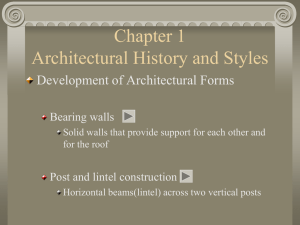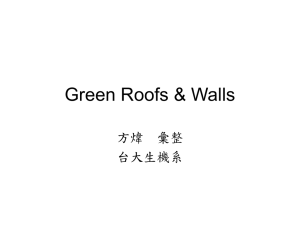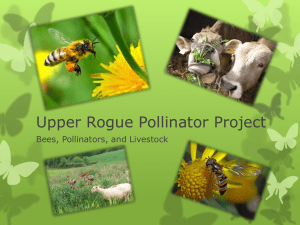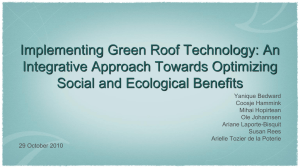Here is the Original File - University of New Hampshire
advertisement
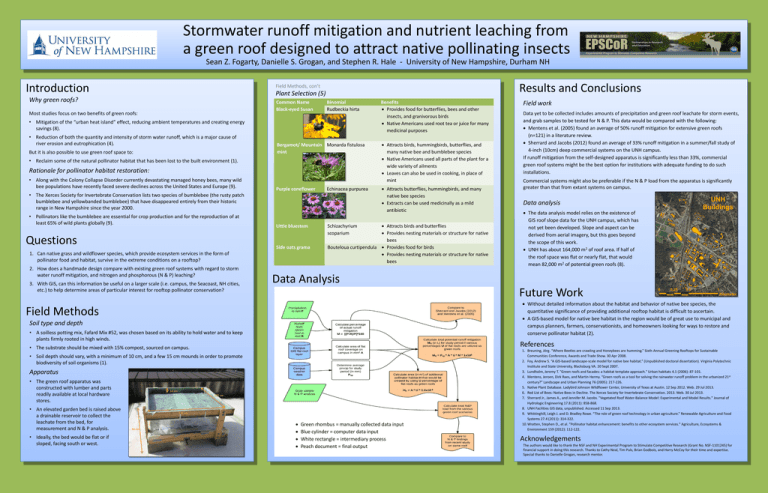
Stormwater runoff mitigation and nutrient leaching from a green roof designed to attract native pollinating insects Sean Z. Fogarty, Danielle S. Grogan, and Stephen R. Hale - University of New Hampshire, Durham NH Introduction Results and Conclusions Field Methods, con’t Plant Selection (5) Why green roofs? Common Name Black-eyed Susan Most studies focus on two benefits of green roofs: Binomial Rudbeckia hirta • Mitigation of the “urban heat island” effect, reducing ambient temperatures and creating energy savings (8). • Reduction of both the quantity and intensity of storm water runoff, which is a major cause of river erosion and eutrophication (4). But it is also possible to use green roof space to: Bergamot/ Mountain Monarda fistulosa mint • Reclaim some of the natural pollinator habitat that has been lost to the built environment (1). Rationale for pollinator habitat restoration: • Along with the Colony Collapse Disorder currently devastating managed honey bees, many wild bee populations have recently faced severe declines across the United States and Europe (9). Purple coneflower Echinacea purpurea • The Xerces Society for Invertebrate Conservation lists two species of bumblebee (the rusty patch bumblebee and yellowbanded bumblebee) that have disappeared entirely from their historic range in New Hampshire since the year 2000. • Pollinators like the bumblebee are essential for crop production and for the reproduction of at least 65% of wild plants globally (9). Questions Little bluestem Side oats grama 1. Can native grass and wildflower species, which provide ecosystem services in the form of pollinator food and habitat, survive in the extreme conditions on a rooftop? 2. How does a handmade design compare with existing green roof systems with regard to storm water runoff mitigation, and nitrogen and phosphorous (N & P) leaching? 3. With GIS, can this information be useful on a larger scale (i.e. campus, the Seacoast, NH cities, etc.) to help determine areas of particular interest for rooftop pollinator conservation? Benefits Provides food for butterflies, bees and other insects, and granivorous birds Native Americans used root tea or juice for many medicinal purposes Attracts birds, hummingbirds, butterflies, and many native bee and bumblebee species Native Americans used all parts of the plant for a wide variety of ailments Leaves can also be used in cooking, in place of mint Attracts butterflies, hummingbirds, and many native bee species Extracts can be used medicinally as a mild antibiotic Attracts birds and butterflies Provides nesting materials or structure for native bees Bouteloua curtipendula Provides food for birds Provides nesting materials or structure for native bees Schizachyrium scoparium The data analysis model relies on the existence of GIS roof slope data for the UNH campus, which has not yet been developed. Slope and aspect can be derived from aerial imagery, but this goes beyond the scope of this work. UNH has about 164,000 m2 of roof area. If half of the roof space was flat or nearly flat, that would mean 82,000 m2 of potential green roofs (8). References • The substrate should be mixed with 15% compost, sourced on campus. • Soil depth should vary, with a minimum of 10 cm, and a few 15 cm mounds in order to promote biodiversity of soil organisms (1). Apparatus • Ideally, the bed would be flat or if sloped, facing south or west. Data analysis Without detailed information about the habitat and behavior of native bee species, the quantitative significance of providing additional rooftop habitat is difficult to ascertain. A GIS-based model for native bee habitat in the region would be of great use to municipal and campus planners, farmers, conservationists, and homeowners looking for ways to restore and conserve pollinator habitat (2). • A soilless potting mix, Fafard Mix #52, was chosen based on its ability to hold water and to keep plants firmly rooted in high winds. 14 cm 122 cm 122 cm 86 cm Commercial systems might also be preferable if the N & P load from the apparatus is significantly greater than that from extant systems on campus. Future Work Soil type and depth • An elevated garden bed is raised above a drainable reservoir to collect the leachate from the bed, for measurement and N & P analysis. Data yet to be collected includes amounts of precipitation and green roof leachate for storm events, and grab samples to be tested for N & P. This data would be compared with the following: Mentens et al. (2005) found an average of 50% runoff mitigation for extensive green roofs (n=121) in a literature review. Sherrard and Jacobs (2012) found an average of 33% runoff mitigation in a summer/fall study of 4-inch (10cm) deep commercial systems on the UNH campus. If runoff mitigation from the self-designed apparatus is significantly less than 33%, commercial green roof systems might be the best option for institutions with adequate funding to do such installations. Data Analysis Field Methods • The green roof apparatus was constructed with lumber and parts readily available at local hardware stores. Field work Green rhombus = manually collected data input Blue cylinder = computer data input White rectangle = intermediary process Peach document = final output 1. Breuning, Jörg. “Where Beetles are crawling and Honeybees are humming.” Sixth Annual Greening Rooftops for Sustainable Communities Conference, Awards and Trade Show. 30 Apr 2008. 2. Foy, Andrew S. “A GIS-based landscape-scale model for native bee habitat.” (Unpublished doctoral dissertation). Virginia Polytechnic Institute and State University, Blacksburg VA. 20 Sept 2007. 3. Lundholm, Jeremy T. "Green roofs and facades: a habitat template approach." Urban habitats 4.1 (2006): 87-101. 4. Mentens, Jeroen, Dirk Raes, and Martin Hermy. “Green roofs as a tool for solving the rainwater runoff problem in the urbanized 21st century?” Landscape and Urban Planning 76 (2005): 217-226. 5. Native Plant Database. Ladybird Johnson Wildflower Center, University of Texas at Austin. 12 Sep 2012. Web. 29 Jul 2013. 6. Red List of Bees: Native Bees in Decline. The Xerces Society for Invertebrate Conservation. 2013. Web. 30 Jul 2013. 7. Sherrard Jr., James A., and Jennifer M. Jacobs. "Vegetated Roof Water-Balance Model: Experimental and Model Results." Journal of Hydrologic Engineering 17.8 (2011): 858-868. 8. UNH Facilities GIS data, unpublished. Accessed 11 Sep 2013. 9. Whittinghill, Leigh J. and D. Bradley Rowe. “The role of green roof technology in urban agriculture.” Renewable Agriculture and Food Systems 27.4 (2011): 314-322. 10.Wratten, Stephen D., et al. "Pollinator habitat enhancement: benefits to other ecosystem services." Agriculture, Ecosystems & Environment 159 (2012): 112-122. Acknowledgements The authors would like to thank the NSF and NH Experimental Program to Stimulate Competitive Research (Grant No. NSF-1101245) for financial support in doing this research. Thanks to Cathy Neal, Tim Puls, Brian Godbois, and Harry McCoy for their time and expertise. Special thanks to Danielle Grogan, research mentor.

